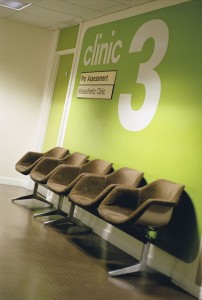At the 2012 American Urological Association Annual Meeting, researchers from around the world present research on a range of urological topics, including the latest information on stone disease, prevention, and treatment. This year the meeting was in Atlanta, Georgia between May 19th and May 23rd, 2012. We’ve selected a few presentations from the meeting below.

Image from Office.com
Drs. Jonathan Shoag and Brian Eisner presented their study, “Kidney stone prevalence is increasing in the United States over the last 2 decades: a comparison of NHANES III and NHANES 2007-2008.” The researchers used a national survey to determine the percentage of Americans reporting a history of stones. They found that compared to data from 1988-1994, Americans in 2007 to 2008 were much more likely to report a history of stones. Overall, 8.5% of Americans report having stones in 2007-8 compared to 5.2% in 1988-1994. Among men, the current percentage is 10.6% while it is 6.4% in women. The increases in stones was seen for all racial groups.

Image from Office.com
Dr. Mohummad Siddiqui and his group presented their study, “Prospective interventional trial of calcium carbonate supplements on hyperoxaluria in stone formers.” The authors performed a study involving 30 patients with high levels of urinary oxalate (a risk factor for forming stones). The subjects were given 1000mg calcium carbonate pills to take at lunch and dinner to determine whether it could lower urinary oxalate levels. Calcium is known to bind to oxalate. Repeat urinary tests were performed after 4 to 6 weeks. The researchers found that urinary oxalate levels decreased after the initiation of the calcium pills, by a mean of 12.1 mg per day. Supersaturation of calcium oxalate, a measure of stone risk, also decreased from 8.03 to 5.06. The authors concluded that taking calcium at meal time may be an effective strategy in reducing stone risk for patients with high urinary oxalate.

Image from iStockphoto
Dr. Carl Sarkissian, from Dr. Manoj Monga’s group, presented their research, “Patient preferences in stone surgery: The informed consent approach”. They examined factors influencing patient decisions to undergo either observation, ureteroscopy, or shockwave lithotripsy. Using a survey of 101 patients, they asked patients which of the three treatment options they would choose if they were given a hypothetical scenario of an 8mm non-symptomatic kidney stone. Patients elected for observation 22.8% of the time, ureteroscopy 29.7% of the time, and shockwave lithotripsy 47.5% of the time. Patients who had successfully passed larger stones or a greater number of stones in the past were more likely to choose observation. When looking at patients who chose surgery as opposed to observation, patients were more likely to choose either ureteroscopy or shockwave lithotripsy if they had previously undergone that same procedure in the past. Previous stone size, time from last stone passage, pain from prior stone episode, and number of stones passed did not impact the decision for one surgery or the other. 56.4% of patients preferred to defer to their doctor to choose the best treatment option for them.

Image from Office.com
Dr. John Hubanks and his group presented their research, “Symptomatic Stone Recurrence Following Ureteroscopy, Percutaneous Nephrolithotomy, and Shockwave Lithotripsy.” The researchers were interested in determining how often symptomatic recurrent stones occurred after each of the three main surgical options for the treatment of stones. They reviewed the records of 333 patients who underwent stone surgery with ureteroscopy, shockwave lithotripsy, or percutaneous nephrolithotripsy. The patients were followed up for the development of repeat stone episode causing symptoms. Repeat stone episodes occurred in 26% of ureteroscopy patients, 32% shockwave lithotripsy patients, and 12% of percutaneous nephrolithotripsy patients. The average time to a repeat episode was 48, 54, and 32 months, respectively. Factors associated with having an increased risk of experiencing a recurrence included a history of prior stone episodes, a history of prior surgery for stones, a family history of stones, and a diagnosis of hyperparathyroidism.
For the last nine months I have been experiencing kidney stones. Not my first in my life but more intense this time. I’m 62 yrs old. This time they have exausted me, phycially and mentally. I have had 2litho’s and 2 or 3 cith etc. I’m recovering now, I hope. So long and complicated. Trust or not trust ur DR. I am healthy no other health problems. I take no meds for anything.,exception is norco. Only from last time when he performed a biopsy on my left kidney, Benign Yeah. I think diet and alcohol, and water play the biggest part in them forming. Need to learn more. Dietician?
the stent is the most pain i have in my life
if a person blood caclium runs at 9.5 would it still be ok to take the caclium
I am trying to decide between shock wave lithotripsy and a uteroscopy for a 1.1 cm (mm?) stone in my kidney. Comments / suggestions??
Take a look at our chart to get a quick overview of the positives and minuses of each approach. There is no wrong or right decision for a stone of that size, your urologist can go over the specifics in your case. In general, the shock wave lithotripsy approach has a lower success rate but has a faster recovery and less discomfort. The ureteroscopic approach has a higher chance of success but can be associated with a slower recovery and more discomfort in some patients.
Thanks for posting what is new in kidney stone research. I was thinking while reading about “Prospective interventional trial of calcium carbonate supplements on hyperoxaluria in stone formers.” why was it that they chose to use calcium carbonate rather than calcium citrate supplements?
The full manuscript for their research has not yet been published. They may comment on their decision to choose calcium carbonate then. It’s possible that the researchers were more interested in the ability of calcium to bind to oxalate in the study. Therefore, the added citrate content of calcium citrate was not a priority.